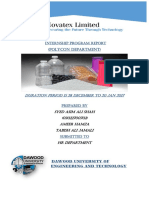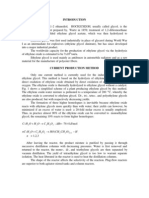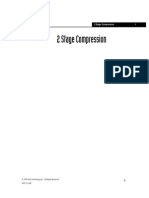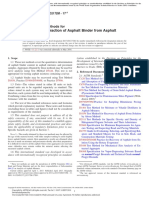Ethylene Glycol Plant
Ethylene Glycol Plant
Uploaded by
ezasukekunCopyright:
Available Formats
Ethylene Glycol Plant
Ethylene Glycol Plant
Uploaded by
ezasukekunCopyright
Available Formats
Share this document
Did you find this document useful?
Is this content inappropriate?
Copyright:
Available Formats
Ethylene Glycol Plant
Ethylene Glycol Plant
Uploaded by
ezasukekunCopyright:
Available Formats
Ethylene Glycol Plant
Ethylene Glycol Plant
2000 AEA Technology plc - All Rights Reserved. Chem 6_3.pdf
Ethylene Glycol Plant
Workshop
Ethylene glycol has many industrial uses: a feed stock for polyester resins, a hydrate inhibitor in natural gas pipelines, an all-weather antifreeze and coolant, or an industrial solvent. Ethylene oxide and water are fed to a reactor to produce ethylene glycol. The product stream is fed to a distillation column where the excess water and ethylene oxide are stripped off the top and the ethylene glycol is the bottom product.
Learning Objectives
After completing this module, you will be able to:
Simulate CSTR reactors Simulate an Ethylene glycol plant Use the recycle operation in HYSYS Choose suitable locations for recycles
Prerequisites
Before beginning this module, you need to be able to:
Add and define the simulation basis, including components, property packages, and reactions. Add streams and operations to a simulation.
Process Overview
Column Overview
Ethylene Glycol Plant
Building the Simulation
Defining the Simulation Basis
Start a New case and choose the NRTL Activity Model. The components are Ethylene Oxide (C2H4O), Water (H2O) and Ethylene Glycol (C2H6O2).
Fast track to page 11.
These components can be hard to find in the long list of available components in HYSYS. Use the Formula filter and type the chemical formulas given above into the Match Cell. This will help you find the desired components quickly and easily. Go to the Binary Coeffs tab. Select UNIFAC VLE as the Coeff Estimation method to estimate the missing binary coefficients and press Unknowns Only. This will estimate the coefficients for the ethylene oxide / ethylene glycol pair.
Adding the Reactions
On the Rxns tab, add the following reaction to the Fluid Package: C2H4O + H2O C2H6O2 1. 2. To define the reaction, press the Simulation Basis Mgr button and select the Reactions tab. Add all of the Fluid Package components by selecting the Add Comps button and pressing the Add this Group of Components button in the window that appears. Press the Add Rxn button, choose Kinetic, and press the Add Reaction button.
3.
In the Stoichiometry and Rate Info group, define the reaction stoichiometry of the reaction previously stated (-1 for reactants, and 1 for product comps).
Ethylene Glycol Plant
4.
Complete the Basis and Parameters pages as below: Enter...
In This Cell...
Basis Basis Base Component Rxn Phase Basis Units Rate Units Parameters Forward Reaction A E
Molar Concn C2Oxide Combined Liquid kgmole/m3 kgmole/m3-s
5.0e+06 5.0e+04
No reverse reaction is defined in this example. 5. Return to the Simulation Basis Manager by closing the Kinetic Reaction window. Return to the Rxns tab of the Fluid Package. Press the Add Set button to add the Global Rxn Set to the Current Reaction Sets group. Close the Fluid Package view. Press the Enter Simulation Environment button.
6.
Ethylene Glycol Plant
Adding the Feed streams
Add two feed streams with the following information. All compositions are entered as mole fractions In This Cell...
Conditions Name Temperature Pressure Molar Flow Composition C2Oxide H2O EGlycol 1.0 0.0 0.0 EOx Feed 25C (77F) 120 kPa (17.4 psia) 105 kgmole/h (230 lbmole/hr)
Enter...
Conditions Name Temperature Pressure Molar Flow Composition C2Oxide H2O EGlycol 0.0 1.0 0.0 Water Feed 25C (77F) 120 kPa (17.4 psia) 150 kgmole/h (330 lbmole/hr)
Save your case!
Ethylene Glycol Plant
Adding the Unit Operations
CSTR Reactor
Add a CSTR operation and enter the following information. Be sure to assign the Global Rxn Set as the Reaction Set for the separator to model the reactor. In This Cell...
Connections Name Inlets Reactor EOx Feed Water Feed Vapour Outlet Liquid Outlet Energy Parameters Pressure Drop Volume 10 kPa (1.5 psi) 2 m3 (71 ft3) Rx Vapour Rx Liquid Rx Coolant
CSTR button
Enter...
1. 2.
On the Reactions tab, select the Global Rxn Set and Rxn-1 as the Reaction. Specify the temperature of stream Rx Liquid to be 65C (150F).
From the Reaction results, what is the % Conversion of Ethylene Oxide? __________
Ethylene Glycol Plant
Ethylene Glycol Tower
The Ethylene Glycol tower will be modelled as a Distillation Column. Add the column with the following information: In This Cell...
Connections Name No. of Stages Inlet Condenser Type Ovhd Vapour Ovhd Liquid Bottoms Liquid Condenser Energy Reboiler Energy Pressures Condenser Condenser Delta P Reboiler Specs Vapour Rate Reflux Ratio Reboiler Temperature 0.0 kgmole/h (0.0 lbmole/hr) 3.0 150C (300F) 100 kPa (14.5 psia) 0 kPa (0 psi) 105 kPa (15 psia) T-100 10 Rx Liquid, Stage 5 Partial Vent Distillate Bottoms Product Cond Duty Reboiler Duty
Enter...
Note: HYSYS generates column temperature estimates if none are provided.
Save your case!
10
Ethylene Glycol Plant
Installing the Recycle
A Recycle operation is a mathematical unit operation and is installed as any other. It has an inlet (calculated) stream and an outlet (assumed) stream. The operation is called/calculated whenever changes to the inlet stream fall outside of the converged tolerance. The Recycle installs a theoretical block in the process stream. The feed into the block is termed the calculated recycle stream, and the product is the assumed recycle stream. The following steps take place during the convergence process
In general, a Recycle operation is required for material transfer and not for thermal recycles. Always supply a guess or starting point for the outlet stream of the Recycle, never the inlet. A guess close to the solution will result in a faster convergence time.
HYSYS uses the conditions of the assumed stream (outlet) and solves the flowsheet up to the calculated stream (inlet). HYSYS then compares the values of the calculated stream to those in the assumed stream. Based on the difference between the values, HYSYS modifies the values in the calculated stream and passes the modified values to the assumed stream.
The calculation process repeats until the values in the calculated stream match those in the assumed stream within specified tolerances.
10
Ethylene Glycol Plant
11
Recycle the Water Stream
The stream Distillate contains mostly unreacted water. This water can be recycled to the reactor in order to reduce the feed water requirements (as well as eliminate a waste stream).
Open the case OptRecy.hsc
Install a Recycle block operation. The inlet stream is the Distillate and the outlet stream should be mixed with the pure Water Feed stream, before entering the Reactor. Delete the specified molar flow rate of the Water Feed stream. This value will be back-calculated from the outlet of the mixer. Specify the molar flow of the mixer outlet stream, Water to Reactor, as 150 kgmole/h (330 lbmole/hr). Once the flow rate in this stream is set, HYSYS will automatically calculate the flowrate of the Water Feed stream. If we had not deleted the specified value, HYSYS would report a consistency error, because a the two values would be in conflict with each other. What value does HYSYS calculate for the flowrate of the stream "Water Feed"? __________
11
12
Ethylene Glycol Plant
Parameters tab
Tolerance page
The smaller the tolerance value, the tighter the tolerance. Generally it is a good idea to start with the default tolerance until you have a converged solution and then tighten the tolerance.
HYSYS allows you to set the convergence criteria or tolerance for each of the Recycle variables. In this example, leave everything at the default.
Numerical Page
This page contains the options for the two types of Recycles, Nested and Simultaneous.
Nested - this type of recycle gets called whenever it is encountered during calculations. Use this type if you have a single Recycle or if you have multiple recycles which are not connected. Simultaneous - all recycles set at Simultaneous will be called at the same time. Use this option if your Flowsheet has multiple inter-connected recycles.
Change the Maximum Iterations number to 20.
12
Ethylene Glycol Plant
13
Monitor tab
This page displays convergence information as the calculations are performed. Any variable that changes between iterations is displayed in this table.
Worksheet tab
The Recycle WorkSheet page displays the Inlet and Outlet stream information. In this instance, notice that the Inlet and Outlet streams have the same values. This is because before we installed the Recycle, the Inlet stream was already calculated by HYSYS. When the Recycle was connected, the known Inlet conditions were automatically passed to the Outlet stream to serve as the starting guess.
13
14
Ethylene Glycol Plant
Exploring with the Simulation
Exercise 1
Create a Case Study to plot the Ethylene Glycol molar flow in the liquid product against the Reactor Outlet Temperature. The temperature range can be between 45 and 110 C (100 and 240 F), with a step of 10 C (20 F). Be sure to "Ignore" the Recycle operation before starting the Case Study. What temperature produces the maximum Ethylene Glycol flow? __________ What problems will be encountered if the temperature exceeds approximately 115 oC? __________ Remember to save the file under a different name if you wish to save it!
Exercise 2
Set up an Adjust operation to make sure the molar flow of Ethylene Glycol in the Rx Liquid stream is equal to 110 kgmole/h (240 lbmole/ hr), by adjusting the EOx Feed molar flow with a step size of 1 kgmole/h (2 lbmole/hr). What EtOx feed rate is required to produce the specified molar flow of Ethylene Glycol? __________
14
Ethylene Glycol Plant
15
Advanced Modelling
Because the Recycle operation is a mathematical representation of a physical process, its location in a simulation is a particularly important one. The location of the tear stream can often determine success or failure to converge a recycle
Choose a Tear Location to Minimize the Number of Recycles
Reducing the number of locations where the iterative process is required will save on the total convergence time. Choosing the location of the Recycle will depend on the Flowsheet topology. Attempt to choose a point such that specifying the assumed stream will define as many streams downstream as possible. It generally occurs downstream of gathering points (mixers) and upstream of distribution points (tees, separators, and columns).
Choose a Tear Location to Minimize the Number of Recycle Variables
Variables include vapour fraction, temperature, pressure, flow, enthalpy and composition. Choose the tear stream so that as many variables as possible are fixed, thus effectively eliminating them as variables and increasing convergence stability. Good choices for these locations are at separator inlets, compressor after cooler outlets and trim heater outlets.
A very poor choice of a tear stream is a stream with an Adjust operation controlling one of its variables.
Choose a Stable Tear Location
The tear locations can be chosen such that fluctuations in the recycle stream have a minimal effect. For example, by placing the tear in a main stream, instead of the physical recycle, the effect of fluctuations will be reduced. The importance of this factor depends on the convergence algorithm. It is more significant when successive substitution is used.
15
16
Ethylene Glycol Plant
Recycle Exercises
Choosing the Right Location
When installing Recycle operations in a HYSYS simulation, it is vital that right location for the operation be chosen. Several guidelines were given on a previous page, and several different problems will be given here. Note that some of these flowsheet may require more than one Recycle operation.
Flowsheet 1
Where should the Recycle be placed in this flowsheet and why? Assume that you know the following information:
Temperature and Vapour Fraction of "Cond Out". Pressure drop and Duty of "Chiller" operation. Pressure of "Chiller Out" stream. Pressure drop of "Condenser" Operation. The Mixer is set to "equalize all."
16
Ethylene Glycol Plant
17
Flowsheet 2
Where should the Recycle be placed in this flowsheet and why? Assume that the Feed is fully defined, Shell and Tube Side pressure drops are known, as well as the Column Feed temperature.
Flowsheet 3
Where should the Recycle be placed in this flowsheet and why? Assume the Feed is completely defined, shell and tube side pressure drops for E-100 and E-101, and the temperatures of streams 3 and 4 are known.
17
18
Ethylene Glycol Plant
Flowsheet 4
Where should the Recycle be placed in this flowsheet and why? Assume the Feed is completely defined, and the shell and tube side pressure drop for E-100 is known.
18
You might also like
- 41.1.28 AOAC Official Method 969.33 Fatty Acids in Oils and FatsNo ratings yet41.1.28 AOAC Official Method 969.33 Fatty Acids in Oils and Fats1 page
- Production of 30 000 Metric Tonnes of Butanol Per Year100% (1)Production of 30 000 Metric Tonnes of Butanol Per Year710 pages
- Acetaldehyde Production by Ethanol Dehydrogenation PDFNo ratings yetAcetaldehyde Production by Ethanol Dehydrogenation PDF1 page
- CPE603 Assignment ASPEN HYSYS Simulation PDFNo ratings yetCPE603 Assignment ASPEN HYSYS Simulation PDF49 pages
- Aspen HYSYS - Steady States and Dynamic Simulator (EG Plant Exercise) PDFNo ratings yetAspen HYSYS - Steady States and Dynamic Simulator (EG Plant Exercise) PDF10 pages
- Design of An Ethylene Oxide Production Process100% (5)Design of An Ethylene Oxide Production Process13 pages
- Production of Mono Ethylene Glycol by Hy PDFNo ratings yetProduction of Mono Ethylene Glycol by Hy PDF2 pages
- Acetaldehyde - Chemical Economics Handbook (CEH) - IHS MarkitNo ratings yetAcetaldehyde - Chemical Economics Handbook (CEH) - IHS Markit5 pages
- Final Design Report Group 6 (Latest) PDFNo ratings yetFinal Design Report Group 6 (Latest) PDF385 pages
- Simulation of Waste Plastic Pyrolysis Hysys V9 Steady ConditionNo ratings yetSimulation of Waste Plastic Pyrolysis Hysys V9 Steady Condition10 pages
- Energy Balances and Numerical Methods Design ProjectNo ratings yetEnergy Balances and Numerical Methods Design Project8 pages
- Process Design For The Production of Ethylene From EthanolNo ratings yetProcess Design For The Production of Ethylene From Ethanol145 pages
- CPE639 Mini Project - Production of Acetonitrile Using Fluidized Bed Reactor PDFNo ratings yetCPE639 Mini Project - Production of Acetonitrile Using Fluidized Bed Reactor PDF41 pages
- Chemical Process Design and Simulation: Aspen Plus and Aspen Hysys ApplicationsFrom EverandChemical Process Design and Simulation: Aspen Plus and Aspen Hysys Applications2/5 (1)
- Aspen Hysys Azeo Distillation With LL Extractor PDFNo ratings yetAspen Hysys Azeo Distillation With LL Extractor PDF26 pages
- 1902 - Rayleigh - On The Distillation of Binary MixturesNo ratings yet1902 - Rayleigh - On The Distillation of Binary Mixtures17 pages
- ISTEC 2011: Simulation and Optimization of Ethyl Acetate Reactive Packed Distillation Process Using Aspen HysysNo ratings yetISTEC 2011: Simulation and Optimization of Ethyl Acetate Reactive Packed Distillation Process Using Aspen Hysys6 pages
- Application of Distillation & Leaching (Autosaved)No ratings yetApplication of Distillation & Leaching (Autosaved)14 pages
- Getting Started With Aspen Batch Distillation: Image/gs - 1.gifNo ratings yetGetting Started With Aspen Batch Distillation: Image/gs - 1.gif26 pages
- Exploring Diversity of Matter Using Separation Techniques CollatedNo ratings yetExploring Diversity of Matter Using Separation Techniques Collated72 pages
- BKF3553 Process Simulation & Computer Aided Design Sem II 2019/2020No ratings yetBKF3553 Process Simulation & Computer Aided Design Sem II 2019/202048 pages
- Performance of Wire Mesh Mist EliminatorNo ratings yetPerformance of Wire Mesh Mist Eliminator11 pages
- 41.1.28 AOAC Official Method 969.33 Fatty Acids in Oils and Fats41.1.28 AOAC Official Method 969.33 Fatty Acids in Oils and Fats
- Production of 30 000 Metric Tonnes of Butanol Per YearProduction of 30 000 Metric Tonnes of Butanol Per Year
- Acetaldehyde Production by Ethanol Dehydrogenation PDFAcetaldehyde Production by Ethanol Dehydrogenation PDF
- Aspen HYSYS - Steady States and Dynamic Simulator (EG Plant Exercise) PDFAspen HYSYS - Steady States and Dynamic Simulator (EG Plant Exercise) PDF
- Distillation Design and Control Using Aspen SimulationFrom EverandDistillation Design and Control Using Aspen Simulation
- Acetaldehyde - Chemical Economics Handbook (CEH) - IHS MarkitAcetaldehyde - Chemical Economics Handbook (CEH) - IHS Markit
- Simulation of Waste Plastic Pyrolysis Hysys V9 Steady ConditionSimulation of Waste Plastic Pyrolysis Hysys V9 Steady Condition
- Energy Balances and Numerical Methods Design ProjectEnergy Balances and Numerical Methods Design Project
- Process Design For The Production of Ethylene From EthanolProcess Design For The Production of Ethylene From Ethanol
- CPE639 Mini Project - Production of Acetonitrile Using Fluidized Bed Reactor PDFCPE639 Mini Project - Production of Acetonitrile Using Fluidized Bed Reactor PDF
- Chemical Process Design and Simulation: Aspen Plus and Aspen Hysys ApplicationsFrom EverandChemical Process Design and Simulation: Aspen Plus and Aspen Hysys Applications
- Aspen Hysys Azeo Distillation With LL Extractor PDFAspen Hysys Azeo Distillation With LL Extractor PDF
- 1902 - Rayleigh - On The Distillation of Binary Mixtures1902 - Rayleigh - On The Distillation of Binary Mixtures
- ISTEC 2011: Simulation and Optimization of Ethyl Acetate Reactive Packed Distillation Process Using Aspen HysysISTEC 2011: Simulation and Optimization of Ethyl Acetate Reactive Packed Distillation Process Using Aspen Hysys
- Application of Distillation & Leaching (Autosaved)Application of Distillation & Leaching (Autosaved)
- Getting Started With Aspen Batch Distillation: Image/gs - 1.gifGetting Started With Aspen Batch Distillation: Image/gs - 1.gif
- Exploring Diversity of Matter Using Separation Techniques CollatedExploring Diversity of Matter Using Separation Techniques Collated
- BKF3553 Process Simulation & Computer Aided Design Sem II 2019/2020BKF3553 Process Simulation & Computer Aided Design Sem II 2019/2020

























































































